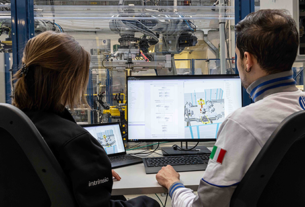Technology advances at a furious pace these days. Innovative new software products and hardware devices are conceived daily to connect our increasingly digital world further, and organizations across industries are struggling to keep up.
Once thought simply of as trendy ideas or intriguing concepts from the world of science fiction, technologies like the cloud, artificial intelligence, and virtual reality are all now common, with myriad real-world applications.
You Can Harness Technology Trends — With Great Benefits to Your Business
While leveraging those technologies to benefit your business once involved, assuming a significant amount of risk, countless companies are embracing the technological evolution to realize the benefits of remaining near technology’s cutting edge.
Take Advantage of Your Best Opportunities
Today, the rate of innovation still makes many businesses nervous about the future. Entirely too many businesses feel they’re “playing it safe” by ignoring the latest technology trends. Others do not even have teams capable of harnessing the latest and greatest. Whatever the reason, these organizations are missing out on opportunities to save money, improve efficiencies or otherwise boost their businesses.
Custom Software Development
Enter custom software development. Custom software design and development expertise empower organizations from any sector to utilize technology trends to propel their businesses into the future. The software your business uses today impacts tomorrow’s results, so understanding these trends can help reduce complexity and boost business efficiency.
Context-Aware Mobile Apps
Defined as “systems that can sense clues about the situational environment and enable appropriate mechanisms of interaction between end users and systems,” context-aware mobile applications improve the intelligence, adaptivity, and personalization of mobile devices.
With users increasingly able to surf the internet, play games, send/receive emails, listen to music, and even watch video content straight from their smartphone or tablet, mobile technology has become a pervasive, ubiquitous element of our lives.
Wherever we go, most of us haul a mobile device in tow, whether to the kitchen, bathroom, library, or movie theater, out to dinner, or even on a hike. And it’s mobile applications that provide us with the services and information we deem important enough to engrain these gadgets into our daily routines.
If a mobile app is able to understand the context — the user, situation, or combination of environmental variables — to make mobile devices smarter, it is “context-aware” and capable of unlocking important practical applications, from location-based services to patient care to everything in between.
What’s Your Next Phone App? Improve Our Lives
Most of our smartphones are equipped with myriad sensors and services that applications can utilize to establish context and improve our lives:
- Accelerometer
- Altimeter
- Ambient temperature sensor
- Gravity sensor
- Gyroscope
- Location/GPS sensor
- Magnetometer
- Microphone
- Pedometer
Other apps use circumstantial data, such as demographics and behavior profiles, to glean immediate information about a user’s context and deliver tailored experiences.
More Context-Aware Mobile Application
The challenge, however, is building a context-aware mobile application with robust features and functionality and an engaging, delightful user experience that requires a rigorous design and development process.
There are myriad technical challenges and considerations associated with the development of context-aware mobile apps — from power and memory to internet connectivity and beyond — and delivering an app with a poor UX can negatively impact your reputation and bottom line.
Partnering with an experienced custom software development company can help companies harness the advantages of context awareness to improve their businesses via timely, relevant, and appropriate information, notifications, and functionality.
Edge Computing
Just like how cloud computing progressed from an industry buzzword to the typical way organizations store, manage, and process data, edge computing is now having its moment. This innovative computing concept enables remote devices to process information at a network’s “edge” instead of using cloud services, where latency is becoming increasingly noticeable.
According to Gartner, more than 75% of enterprise data will be created and processed outside the data center or cloud in the near future, so data-dependent organizations must adjust how they handle computing.
By moving computing power closer to where data is generated, edge computing helps reduce network congestion and latency — and ultimately enables organizations to extract the maximum amount of value from their data in a timely manner.
The Critical Cost of Not Using Edge Computing
Without edge computing, IT costs balloon as the deluge of data generated by edge devices and IoT-connected sensors hamstrings business networks, disrupting all operations across impacted networks. In some worst-case scenarios, critical machinery could malfunction or be damaged, and employees could even be injured or, worse yet, killed.
By reducing response times and lowering the amount of bandwidth organizations use, edge computing can speed data processing, enhance security and safety, improve productivity, and minimize costs.
But since organizations require real-time responses to massive amounts of data as the Internet of Things advances, any errors during the software design and development process can introduce a new set of technical challenges to the network.
Extended Reality
Immersive technologies transform how we live, work, learn and play; extended reality — or XR — is the umbrella term for innovations like virtual reality, augmented reality, and mixed reality that enable users to experience life in a way that extends beyond the present reality. A market expected to grow by about 60% in the next five years, XR allows individuals to create, collaborate and explore in unprecedented — and engaging — digital environments.
Virtual Reality
Virtual reality creates virtual environments that can push the boundary between a simulated environment and the real world. Whether immersing gamers in the story, sports fans in the game, architects in their building designs, or homebuyers in their dream houses, VR has countless applications that extend our reality to unlock benefits for businesses across industries.
Augmented Reality
Augmented reality, which is largely synonymous with mixed reality, involves supplementing our reality with computer-generated content rendered into the real world. AR brings a new kind of interactive experience to users by displaying rendered graphics through smartphones, tablets, and other devices.
Popularized by apps like Pokémon Go and Snapchat, AR has been explored for many applications and can also span multiple sensory modalities to deliver value across application areas.
While extended reality allows many people to live more comfortably and efficiently, cost, comfort, connectivity, and data privacy concerns can hinder the adoption of XR technologies — especially if such technologies are not designed into an application in an efficient, user-friendly way.
“Zero Trust” Security
Demanding verification from everyone — both inside and outside a network — to gain access to resources on a private network, zero trust aims to prevent data breaches by trusting no one and nothing.
Because verification is required from every user and device trying to gain access to resources on the network, the added layer of security is proven to prevent harmful attacks — whether reputationally or financially — data breaches. Zero trust uniquely addresses the modern challenges of today’s business by rightly assuming there is no traditional network edge.
A significant departure from traditional network security, zero trust requires continuous monitoring and validation that a user and their device have the right privileges and attributes and policy enforcement incorporating user and device risk, compliance, and other requirements. The challenge is finding that delicate balance between user-friendly and secure.
With far-flung user and application identity attributes to consider, too many companies fail to build security into their solution from step one — and the consequences can be devastating.
If your team isn’t prepared to address device-specific credential privileges, geolocation, firmware and operating system version challenges, or incident detection, find a custom software design partner that understands the chain that your company’s IT system is only as strong as its weakest link.
The Value of Expert-Vetted Custom Software Design Expertise
Clearly, as different technologies continue advancing, the promise of the IoT will continue delivering incredible new experiences that transform businesses and delight consumers.
Whether sensing the environment around devices, boosting processing power, immersing users in simulated environments, or enhancing data protection, 2023 technology trends will only strengthen our relationship with our continuously more tech-driven world.
But it is also apparent that harnessing technology trends to boost customer service or an organization’s internal work with software is difficult without the right expertise and experience.
Conclusion
Countless software design and development companies talk a big game but fail to keep pace with the rapid acceleration of technology. That’s why it’s important to partner with an expert-vetted custom software design firm to tailor an innovative solution to your unique needs and elevate your business.
Featured Image Credit: Photo by Yan Krukau; Pexels; Thank you!



